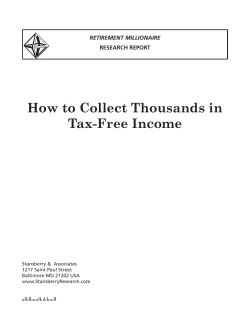
Algorithms in Percolation Problem: how to identify and measure cluster size
Algorithms in Percolation Problem: how to identify and measure cluster size distribution 1 Single-Cluster growth “Leath-Alexandrowicz method” Paul Leath Rutgers University P. L. Leath, Phys. Rev. B 14, 5046 (1976) Z. Alexandrowicz, Phys. Lett. A 80, 284 (1980). 2 Leath-Alexandrowicz Algorithm • “Grow” clusters by adding sites one at a time from an initial seed • Two methods: – “Breadth first” or “First-In-First-Out” (FIFO) • Requires making a list or queue – “Depth first” or “Last-In-Last-Out” (LIFO) • Can be done using stack and recursion 3 FIFO site percolation Start with a seed site that is “wet” Check neighbors in this order: 2 3 1 4 4 FIFO site percolation Occupy a site with probability p Orange = first shell Unchecked sites queue: 5 FIFO site percolation Occupy a site with probability p Orange = first shell Unchecked sites queue: 6 FIFO site percolation Make site “vacant” with probability 1-p Orange = first shell Unchecked sites queue: 7 FIFO site percolation Make site “vacant” with probability 1-p Orange = first shell Unchecked sites queue: 8 FIFO site percolation Make site “vacant” with probability 1-p Orange = first shell Unchecked sites queue: 9 FIFO site percolation Green = second shell Unchecked sites queue: 10 FIFO site percolation Green = second shell Unchecked sites queue: 11 FIFO site percolation Green = second shell Unchecked sites queue: 12 FIFO site percolation Green = second shell Unchecked sites queue: 13 FIFO site percolation Green = second shell Unchecked sites queue: 14 FIFO site percolation Blue = third shell Unchecked sites queue: 15 FIFO site percolation Blue = third shell Unchecked sites queue: 16 FIFO site percolation Blue = third shell Unchecked sites queue: 17 FIFO site percolation Blue = third shell Unchecked sites queue: 18 FIFO site percolation Violet = fourth shell Unchecked sites queue: 19 FIFO site percolation Violet = fourth shell Unchecked sites queue: 20 FIFO algorithm “Pop” new growth site from queue For (neighbors = 1 to 4) if (neighbor == unvisited) if (randomnumber < prob) neighbor = occupied “push” neighbor on queue else neighbor = vacant. LIFO site percolation 22 LIFO site percolation Orange = growth from first neighbor of seed 23 LIFO site percolation Orange = growth from first neighbor of seed 24 LIFO site percolation Orange = growth from first neighbor of seed 25 LIFO site percolation Orange = growth from first neighbor of seed 26 LIFO site percolation Orange = growth from first neighbor of seed 27 LIFO site percolation Orange = growth from first neighbor of seed Put all growing sites on a stack 28 LIFO site percolation Orange = growth from first neighbor of seed 29 LIFO site percolation Orange = growth from first neighbor of seed 30 LIFO site percolation Orange = growth from first neighbor of seed 31 LIFO site percolation Orange = growth from first neighbor of seed 32 LIFO site percolation Orange = growth from first neighbor of seed 33 LIFO site percolation Orange = growth from first neighbor of seed 34 LIFO site percolation Orange = growth from first neighbor of seed 35 LIFO site percolation Blue = growth from third neighbor of seed 36 LIFO site percolation Violet = growth from fourth neighbor of seed 37 LIFO algorithm (can also use recursion) Get new growth site from stack For (neighbors = 1 to 4) if (neighbor == unvisited) if (randomnumber < prob) neighbor = occupied put neighbor on stack else neighbor = vacant. FIFO bond percolation Red = seed “activated” or “wet” site 39 FIFO bond percolation Orange = first shell of bonds Add bonds to dry sites with probability p 40 FIFO bond percolation Orange = first shell of bonds Add bonds to dry sites with probability p 41 FIFO bond percolation Orange = first shell of bonds Vacant bond with probability 1 - p 42 FIFO bond percolation Orange = first shell of bonds Vacant bond with probability 1 - p 43 FIFO bond percolation Green = second shell of bonds 44 FIFO bond percolation Green = second shell of bonds 45 FIFO bond percolation Green = second shell of bonds 46 FIFO bond percolation Green = second shell of bonds Here we are concerned with the wet sites only and do not add bonds already wet sites 47 FIFO bond percolation Green = second shell of bonds Here we are concerned with the wet sites only and do not add bonds already wet sites 48 FIFO bond percolation Blue = third shell of bonds Here we are concerned with the wet sites only and do not add bonds already wet sites 49 FIFO bond percolation Blue = third shell of bonds Here we are concerned with the wet sites only and do not add bonds already wet sites 50 FIFO bond percolation Blue = third shell of bonds Here we are concerned with the wet sites only and do not add bonds already wet sites 51 FIFO bond percolation Blue = third shell of bonds Here we are concerned with the wet sites only and do not add bonds already wet sites 52 FIFO bond percolation Violet = fourth shell of bonds Here we are concerned with the wet sites only and do not add bonds already wet sites 53 FIFO bond percolation Violet = fourth shell of bonds The final object is a minimally spanning tree that connects to every wet site of the cluster 54 FIFO bond percolation (finding wetted sites) “Pop” new growth site from queue For (neighbors = 1 to 4) if (neighbor == unvisited) if (randomnumber < prob) Identical to FIFO site perc. except neighbor = occupied for this line being taken out “push” neighbor on queue else neighbor = vacant. Hoshen-Kopelman algorithm 1976 Raoul Kopelman, University of Michigan J. Hoshen and R. Kopelman, Phys. Rev. B 14:3438 (1976). 56 Hoshen-Kopelman Algorithm (Bond percolation) Look at last row of growing inteface. Each color represents a connected cluster 57 Hoshen-Kopelman Algorithm (Bond percolation) Add bonds sequentially with probability p 58 Hoshen-Kopelman Algorithm (Bond percolation) Add bonds sequentially with probability p 59 Hoshen-Kopelman Algorithm (Bond percolation) Add bonds sequentially with probability p 60 Hoshen-Kopelman Algorithm (Bond percolation) Add bonds sequentially with probability p 61 Hoshen-Kopelman Algorithm (Bond percolation) Add bonds sequentially with probability p 62 Hoshen-Kopelman Algorithm (Bond percolation) Add bonds sequentially with probability p 63 Hoshen-Kopelman Algorithm (Bond percolation) Add bonds sequentially with probability p 64 Hoshen-Kopelman Algorithm (Bond percolation) Repeat!!!! Can simulate lattices as large as 100,000,000 x 100,000,000 this way!!!!! 65 Newman-Ziff algorithm 2000 66 Newman-Ziff Algorithm Start with an empty lattice, compute Q (Γ0) = Q0 67 Newman-Ziff Algorithm Randomly occupy a bond, compute Q(Γ1) 68 Newman-Ziff Algorithm Randomly occupy an unoccupied bond, compute Q(Γ2) 69 Newman-Ziff Algorithm And so on and compute Q(Γb) with b number of bonds 70 Newman-Ziff Algorithm Until all bonds are occupied, compute Q(ΓM) M is the total number of bonds 71 Newman-Ziff Algorithm • Any quantity as a function of p is computed as M M! Q =∑ p b (1 − p )M −b Qb b = 0 b !(M − b )! where Qb = Q(Γb). • Each sweep takes time of O(N) 72 M. E .J. Newman and R. M. Ziff, Phys. Rev. Letters 85, 4104 (2000) • Bonds are added one at a time, and a bookkeeping scheme is used to keep track of the cluster structure. Mark Newman, U. Michigan data structure • At each lattice site is a variable, ptr[i] • If the ptr[i] > 0, it gives the position of another site on the cluster (a link). • If ptr[i] < 0, “i” is the root of the cluster, and |ptr[i]| gives the number of sites belonging to the cluster. procedure • Initially, a random ordering of the bonds of the system is made • 1. A bond is chosen randomly, and findroot is used to find the root at each end (and the link paths are collapsed) • a) If the two ends belong to different clusters, the two are merged. • b) If both ends of the bond are in the same cluster, nothing is done. findroot Before -- findroot jumps from link to link until it After gets to the root -- when the recursive calls “unwind”, they rename every link to point to the root merging -- the root of the smaller cluster is linked to the root of the larger cluster, and the size is adjusted accordingly convolution To go from the canonical (fixed number of bonds) to the grandcanonical (fixed occupancy p), one must convolve with a : binomial distribution Qn = quantity (such as mean size) for a system of fixed n Q(p) = same quantity for a fixed probability p Example of Exact canonical-grand canonical: the crossing probability of a square system, up to 7 x 7 (from exact enumeration): example: probability of wrapping a square torus in one direction but not the other for all values of p • • • L x L, L = 32, 64, 128, 256 Reaches maximum ≈ pc Excellent convergence: Easily find • pc = 0.5927462.. p “Percolation Threshold” Wikipedia page ns = number of clusters of size s, at the critical threshold pc. τ = 187/91. Used Cardys’ result for crossing of an annulus to find size distribution Simulation results – up to 2.5 x 1011 clusters up to size s = 1000. Explosive growth in clusters created through a biased “Achlioptas” growth process on a regular lattice Achlioptas process • Recently, Achlioptas, D’Sousa, and Spencer considered cluster growth on random (Erdös-Rényi ) lattices by the so-called Achlioptas process: – Pick two bonds – Calculate weight = product of masses of the two clusters the bond connects – Choose bond of lower weight Achlioptas et al, Science 2009 Explosive growth • ER = Erdös-Rényi (regular percolation), BF = Bounded size rule, PR = product rule. C/n = maximum cluster size divided by the number of sites • They find “Explosive Growth” in the PR model. Dimitris Achlioptas, UCSC Raissa D’Sousa, UCD Joel Spencer, NYU Alfréd Rényi 1921-‐1970 Minimum spanning tree My Erdös number is 2 by way of Mark Kac Tree form Achlioptas processes on a regular (percolation) lattices • Define t = time = number of bonds added to connect distinct clusters. • Then, the number of clusters is n – t, where n is the initial number of sites, since adding additional For laQce percolaRon, I find (1024x1024 laQce): Product Rule (PR) C/n t/n Regular percolation transition at t/n = 1 – Nc/n = (7 – 3 √3)/2 = 0.9019 The SIR model on a square lattice Susceptible-Infected-Recovered With David de Souza and Tânia Tomé. • That is S → I with rate (1-c)Ineighbors/4 • I →R with rate c • (I remains I for an exponentially distributed time)
© Copyright 2025











